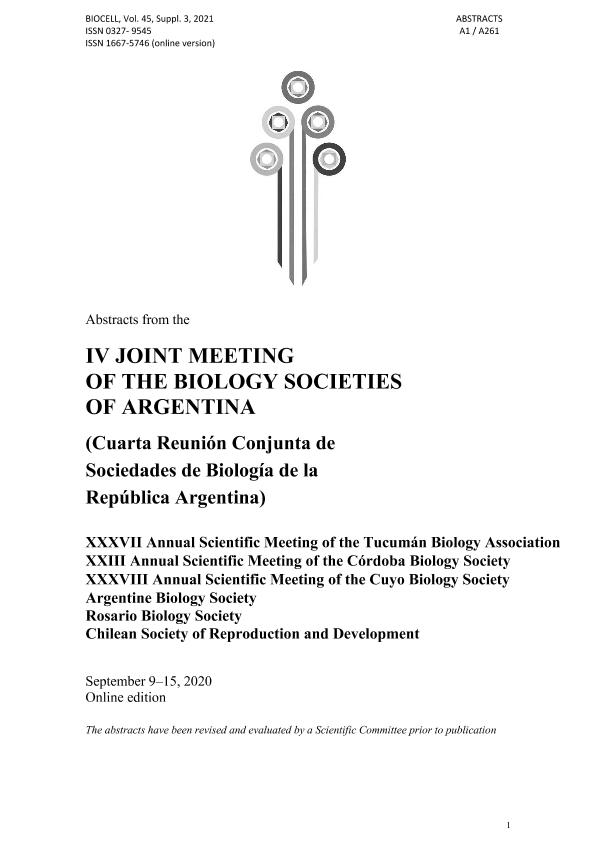Mostrar el registro sencillo del ítem
dc.contributor.author
del Gobbo, Luciana Melisa

dc.contributor.author
Villegas, Liliana Beatriz

dc.contributor.author
Colin, Veronica Leticia

dc.date.available
2022-12-15T17:21:22Z
dc.date.issued
2021
dc.identifier.citation
Study of the protein production of Aspergillus sp. V1 using sugarcane vinasse as substrate; IV Joint Meeting of the Biology Societies of Argentina; Ciudad Autónoma de Buenos Aires; Argentina; 2020; 117
dc.identifier.uri
http://hdl.handle.net/11336/181357
dc.description.abstract
Vinasse is an acidic effluent with a high organic load, which result from ethyl alcohol production. This residue represents a potential hazard for theenvironment if not responsibly managed. Filamentous fungi can adapt to a wide variety of substrates and grow in large quantities on organic wastes.In turn, bioconversion of residues into protein-rich fungal biomass is of great interest since it can be used as an alternative nutrient source to theexpensive aquafeeds such as fishmeal and soybean meal. In a prior study, a filamentous fungus isolated from northwest of the Argentine, Aspergillussp. V1, was able to grow on sugarcane vinasse. The objective of the present work was to evaluate the protein content of Aspergillus sp. V1 biomasscultivated on vinasse, with and without supplement of exogenous nutrients. The optimal vinasse concentration for the growth of Aspergillus sp. V1was determined making dilutions of the residue in distilled water (10% to 100%, v/v) at a final volume of 10 mL. Each dilution was inoculated with1×106spores/mL and incubated at 30ºC (150 rpm) for 96 h under sterile conditions; then dry weight of biomass at 105°C was determined. Biomassproduction was carried out in 200 mL of sterile vinasse at the selected concentration, with and without supplementation of nitrogen and phosphorousin the following combinations: vinasse without nutrient supplementation (B1); vinasse supplemented with 2 g/L of (NH4)2SO4 (B2), or 2 g/L ofCO(NH2)2 (B3); vinasse supplemented with 2 g/L of (NH4)2SO4 and 1 g/L of KH2PO4 (B4), or 2 g/L of CO(NH2)2 and 1 g/L of KH2PO4 (B5). Thebiomass produced was separated by filtration, lyophilized, and weighed. In each case, percentage of total proteins (Kjeldahl-Arnold-Gunning methodusing the universal factor of conversion to protein 6.25) and productivity (in terms of milligrams of protein per liter of culture per h) was determined.The highest growth of Aspergillus sp. V1 was observed in 100% vinasse, with a biomass production of 41.55 g/L thereby following assays wereconducted witn undiluted vinasse. The weight of lyophilized biomasses was 0.89; 0.61; 2.84; 1.00 and 2.99 g/L, with protein percentages of 33%;49%; 41%; 38% and 36%, and a productivity of 3.0; 3.1; 12.0; 4.0 and 11.1 mg/L h for B1, B2, B3, B4 and B5, respectively. According to literature,aquafeeds should contain between 26% to 55% protein. In all cases, protein percentages of Aspergillus sp. V1 biomass were within the desirablerange. However, B3 was selected as the most promising biomass for future assays due to its higher productivity (12.0 mg/L h). Our findingsdemonstrate that the mycelium of Aspergillus sp. V1 grown in vinasse could be a promising and inexpensive protein source to be used as aquafeed.
dc.format
application/pdf
dc.language.iso
eng
dc.publisher
Tech Science Press

dc.rights
info:eu-repo/semantics/openAccess
dc.rights.uri
https://creativecommons.org/licenses/by-nc-sa/2.5/ar/
dc.subject
ASPERGILLUS SP. V1
dc.subject
SUGARCANE VINASSE
dc.subject
AQUAFEEDS
dc.subject
PROTEIN-RICH FUNGAL BIOMASS
dc.subject.classification
Otras Ingeniería del Medio Ambiente

dc.subject.classification
Ingeniería del Medio Ambiente

dc.subject.classification
INGENIERÍAS Y TECNOLOGÍAS

dc.title
Study of the protein production of Aspergillus sp. V1 using sugarcane vinasse as substrate
dc.type
info:eu-repo/semantics/publishedVersion
dc.type
info:eu-repo/semantics/conferenceObject
dc.type
info:ar-repo/semantics/documento de conferencia
dc.date.updated
2022-12-12T23:15:20Z
dc.journal.volume
45
dc.journal.number
Suplemento 3
dc.journal.pagination
117
dc.journal.pais
Argentina

dc.journal.ciudad
Tucuman
dc.description.fil
Fil: del Gobbo, Luciana Melisa. Consejo Nacional de Investigaciones Científicas y Técnicas. Centro Científico Tecnológico Conicet - Tucumán. Planta Piloto de Procesos Industriales Microbiológicos; Argentina
dc.description.fil
Fil: Villegas, Liliana Beatriz. Consejo Nacional de Investigaciones Científicas y Técnicas. Centro Científico Tecnológico Conicet - San Luis. Instituto de Química de San Luis. Universidad Nacional de San Luis. Facultad de Química, Bioquímica y Farmacia. Instituto de Química de San Luis; Argentina
dc.description.fil
Fil: Colin, Veronica Leticia. Consejo Nacional de Investigaciones Científicas y Técnicas. Centro Científico Tecnológico Conicet - Tucumán. Planta Piloto de Procesos Industriales Microbiológicos; Argentina
dc.relation.alternativeid
info:eu-repo/semantics/altIdentifier/url/https://www.techscience.com/biocell/v45nSuppl.3/44000/pdf
dc.conicet.rol
Autor

dc.conicet.rol
Autor

dc.conicet.rol
Autor

dc.coverage
Internacional
dc.type.subtype
Reunión
dc.description.nombreEvento
IV Joint Meeting of the Biology Societies of Argentina
dc.date.evento
2020-09-09
dc.description.ciudadEvento
Ciudad Autónoma de Buenos Aires
dc.description.paisEvento
Argentina

dc.type.publicacion
Journal
dc.description.institucionOrganizadora
Asociación de Biología de Tucumán
dc.description.institucionOrganizadora
Sociedad de Biología de Cuyo
dc.description.institucionOrganizadora
Sociedad de Biología de Córdoba
dc.description.institucionOrganizadora
Sociedad de Biología de Córdoba
dc.description.institucionOrganizadora
Sociedad de Biología de Rosario
dc.description.institucionOrganizadora
Sociedad Argentina de Biología
dc.source.revista
Biocell

dc.date.eventoHasta
2020-09-15
dc.type
Reunión
Archivos asociados
